| Aesthetics | 9.25/10 |
| Protection | 9.25/10 |
| Value | 8.5/10 |
| Comfort/Fit | 9.0/10 |
| Quality/Design | 9.0/10 |
| Weight | 8.75/10 |
| Options/Selection | 9.5/10 |
| Innovation | 9.0/10 |
| Weather Suitability | 9.0/10 |
| Desirable/Cool Factor | 9.25/10 |
| Overall Score | 90.5/100 |
Has it really been six years since the Shoei GT-Air helmet was released? Well, it has, and that means the lid was due for an update – even though, when Troy tested it back in 2017, he said, “[T]he Shoei GT-Air really impresses when it comes to all-day touring comfort. It’s got all the features you’d want from a helmet, with the fit to match.” Using the previous generation as the starting point, Shoei’s designers set out to improve on the already top-notch lid. The result is the brand new Shoei GT-Air II, which ups the ante when it comes to premium touring/sport-touring helmet comfort and utility. To make the helmet even more enticing, Shoei partnered with Sena, as with the Shoei Neotec II, to create a fully-integrated Bluetooth communication system, the Sena SRL2.
MO Tested: Shoei GT-Air Helmet
Shop for the Shoei GT-Air II here
All helmets legally sold in the United States must meet a set standard to get their DOT seal of approval. However, there’s much more to a premium helmet, like a Shoei. Typically, what separates the wheat from the chaff in a street-legal helmet is the relationship between the helmet’s aerodynamics, its comfort features, and its noise levels. Skimp on any one of these features, and the rider’s experience when wearing the helmet is diminished. Getting the best in all three categories requires more development and higher production costs, which ultimately lead to a more expensive helmet than those bargain basement models that seek only to meet the minimum DOT requirements.
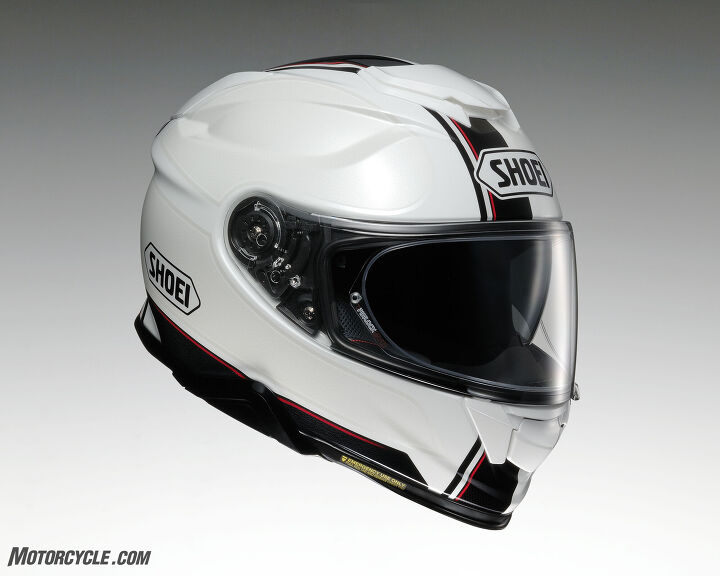
The Shoei GT-Air II fits my medium- to long-oval head almost perfectly. It is exceptionally comfortable over the course of a long day.
When creating the GT-Air II, Shoei’s engineers made subtle-but-noticeable changes to all three areas of the helmet’s function. Taken individually, the changes might not seem like much, but they combine to produce a helmet that is noticeably improved from its predecessor.
Getting slippery
We’ll begin with the most important feature of a motorcycle helmet – aside from the DOT certification – its aerodynamics. Having a helmet that cuts through the air efficiently is important. You don’t want a poorly designed helmet to transmit any unnecessary forces to your neck as you ride. While retaining the same overall look of the original GT-Air, the update has a clearly more angular, aggressive style to it, but Shoei says those changes were dictated by wind tunnel testing, not just styling. Since the GT-Air II is designed for touring and sport-touring riders, the helmet shape was tested in both an upright and slightly leaned forward orientation. My time with the helmet on both standard bikes and those with a sportier riding position have borne out this claim. The helmet stays planted on my head with no lift at speeds that will probably get you arrested. Similarly, turning your head to check blind spots result in a stable head position with no unexpected pulls on the neck.
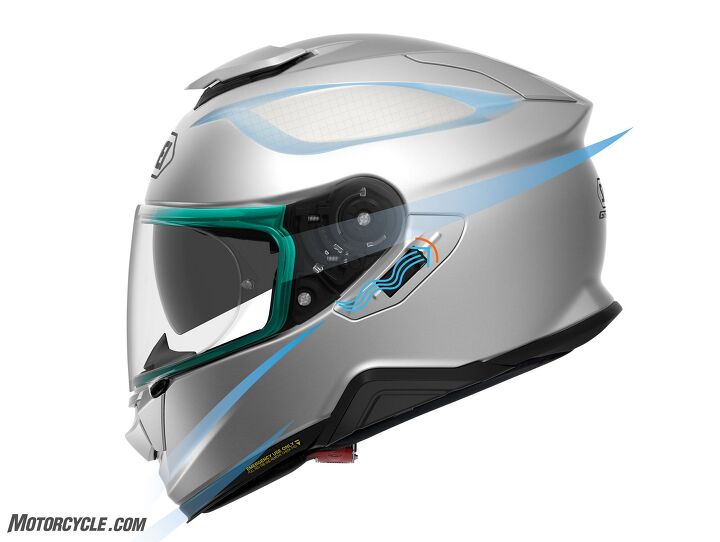
Smooth airflow around the helmet is key to noise reduction. Note how the lip at the bottom of the chin bar directs air from the helmet opening at its base. Also, the hole required for the sun visor’s actuating slider is significantly smaller, letting in less noise.
However, there’s more to a helmet’s relationship to the airflow at speed than just how it slices through it. For the GT-Air II upgrade, the visor baseplate system was completely redesigned. While utilizing the same CNS-1 shield as before, the baseplate combines with similar beading around the eye-port that the Shoei X-Fourteen uses. However, the big news is the new baseplate that the visor mounts to. It is spring-loaded to actually pull the visor tightly against the beading to create an air-tight seal, thus eliminating any whistles that can be caused by this air intrusion. When you close the visor, you can actually feel it lock into place.
Perhaps the biggest news with the improved baseplate, however, is the inclusion of a new venting position. Whereas the previous generation GT-Air opened the visor enough to stick a finger or two between the visor and chin bar, the new baseplate only opens enough to allow a little air in. This can be quite helpful in cooler weather. Although the CNS-1 shield features mounting posts for the included PinLock visor insert, fogging can still be a problem for the internal sun visor or the rider’s glasses. The new opening allows just enough airflow for defogging. Really a nice touch and one I’d been requesting for a long time.
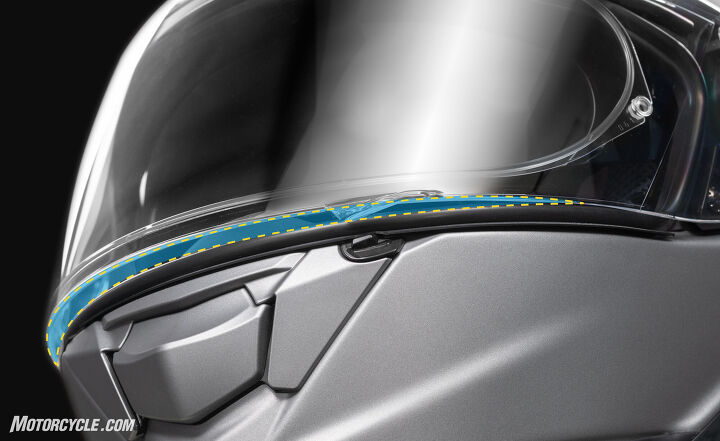
While the Pinlock insert on the visor can help prevent fogging, it does nothing for the rider’s glasses or the internal sun visor. This little opening makes all the difference when riding at low speeds.
Finally, a small inclusion to the outside of the helmet can have a noticeable effect on a helmet’s quietness. On the lower edge of the chin bar, a lip that protrudes into the airflow no more than a millimeter or two, according to Shoei, prevents turbulence from creating noise that enters through the bottom opening of the helmet.
Creature comforts
Having a tinted visor on sunny days is a huge quality of life issue if you’re spending more than a few hours in the saddle. Eventually though, the sun does set, necessitating a visor change, or you’ll be half-blind out on the road. While the GT-Air’s internal sun visor alleviated the need to carry an extra visor, many riders felt that the sun visor didn’t extend far enough down to prevent glare from entering from underneath it. Shoei listened, and the GT-Air II’s sun visor extends 5 mm lower. Although this may not sound like much, when it is this close to your eyes, it makes a world of difference. If you’re unhappy with this change, Shoei included two little levers in the bottom rear corners of the helmet’s eye port that prevent the sun visor from lowering that final 5 mm. (Note for GT-Air owners: The new sun visor will fit your helmet, but it will not extend any lower into your field of vision. Sorry.) Also, the opening in the helmet shell required for the lever that actuates the sun visor has been reduced in size to lessen the exterior noise that the slider allows to the rider’s ears.
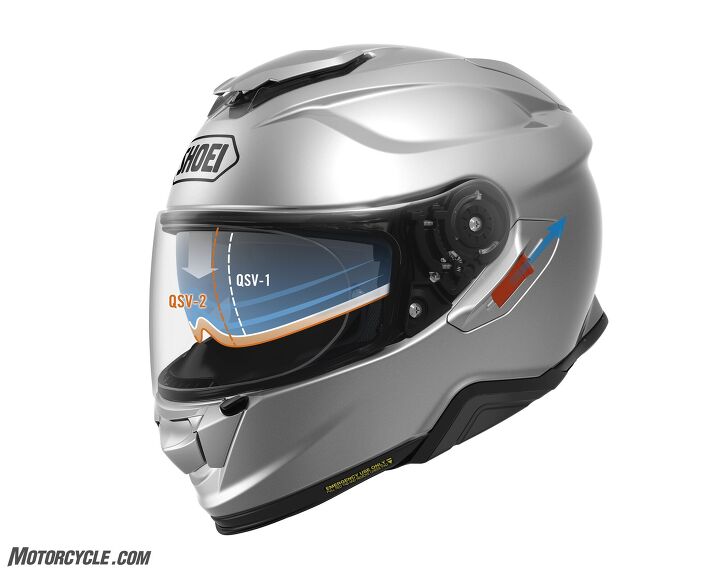
The sun visor may only extend 5 mm lower than before, but it makes a world of difference in blocking out glare.
With every helmet update, one of Shoei’s stated goals is to improve ventilation without negatively affecting the noise level of the helmet. The GT-Air II is no different. The opening in the chin bar is larger and directs the air over the inside of the visor, where the air circulates around in front of the rider’s face, providing cooling. At the top of the head, two vents catch the airflow and channel the air to the helmet interior. A redesigned air intake shutter has three positions closed, half-open, and fully-open. The shutter itself is easy to find and manipulate with a gloved hand, meaning cooling can be adjusted on-the-go. The five exhaust vents are always open.
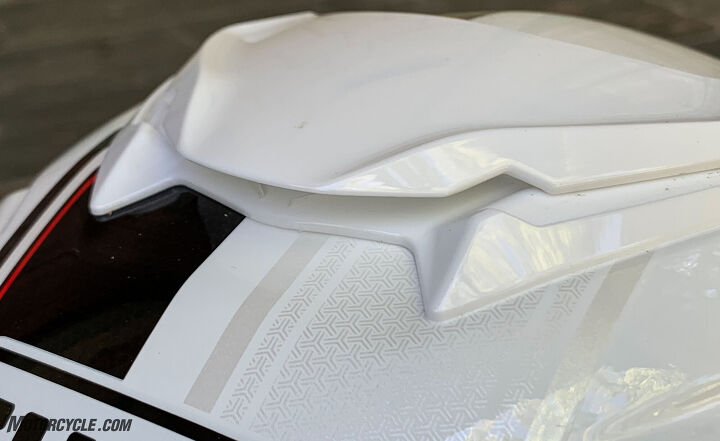
The GT-Air II’s top vent seems to catch the air and scoop it into the openings in the shell – all without any real noise consequence.
My experience with the GT-Air II’s venting is that it is much easier to open the single top vent slider than the hard-to-find dual ones on the Shoei RF-1200 or the difficult to slide one on the Shoei Neotec II. Additionally, the slider’s shape, with its protruding peak, seems to actively catch the air and funnel it into the two top intake ports. In my side-by-side testing with the RF-1200, there appears to be no noise penalty with this setup, while still providing increased airflow.
Quiet, please!
The improved ventilation will be appreciated since the bottom of the helmet is just as snug going on as with the previous generation. The opening is as small as possible to help keep wind noise away from the rider’s ears. Once you’ve squeezed your noggin into the helmet, though, you’ll be coddled by the removable, washable, and supremely comfortable 3D Max-Dry Interior System. Shoei claims the liner is capable of dissipating sweat twice as fast as less-specialized nylon interiors. The multi-layered cheek pads wrap themselves to your facial shape to help seal out noise. Accessory thinner or thicker ones are available to customize your fit.
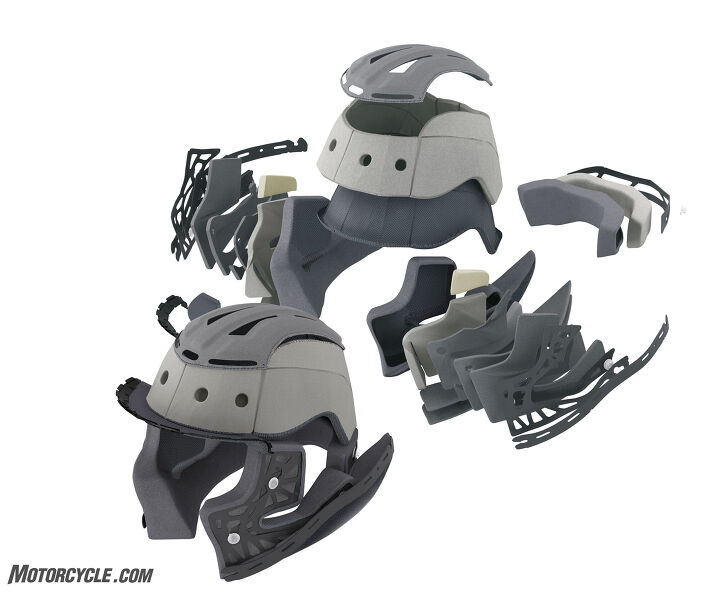
You won’t get attention to liner detail like this in a bargain helmet. If your GT-Air II gets a case of the funk, you can just wash the liner.
The net result of all these small changes in the GT-Air II is that the helmet is pretty dang quiet. I would rate it on par with my quietest helmet, the Shoei RF-1200 with its vents closed. That bit of information aside, I still recommend that you always ride with earplugs to protect your hearing. Even the quietest of helmets has to deal with hurricane force winds on the highway.
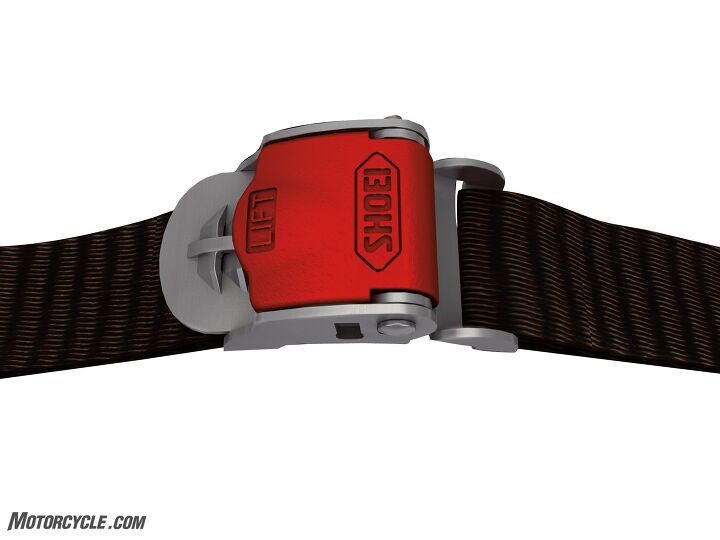
The convenience of the ratcheting buckle can’t be overstated. For those of you who worry, when it has clicked once into place, two stainless steel teeth are securing the buckle. I still let it click twice, just to be safe.
Everything from the exterior finish to the new micro-ratchet chin strap that replaces the traditional double-D ring says that Shoei helmets are premium gear. What you can’t see under the flashy paint is the Multi-Ply Matrix AIM Shell construction, which combines layers of “fiberglass with lightweight organic and high-performance fibers” for lightness, strength, and slight elasticity to absorb impacts. Underneath that shell is the Multi-Piece/Multi-Density EPS Liner that, using Shoei’s varying-density foam, provides impact protection tuned to the amount required for its location and creates the channels for cooling air to flow through.
Sena SRL2
One good reason to be happy that the GT-Air II is a quiet helmet is that Sena and Shoei teamed up to integrate a Bluetooth communication system into the helmet. Now, you can have Siri whisper directions into your ears without an ugly goiter on the outside of your helmet.
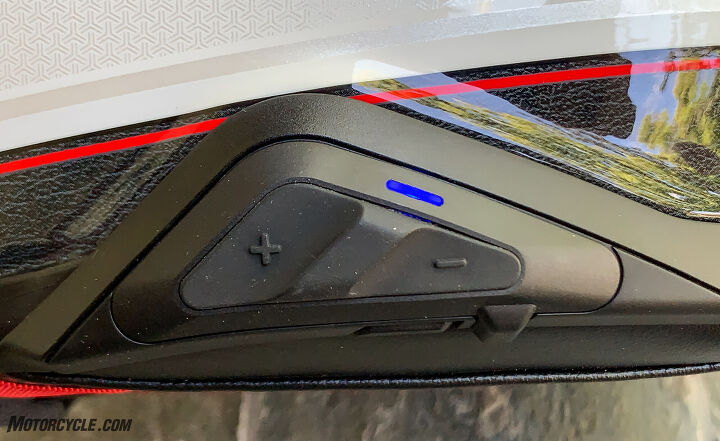
I wish the center button were just a little taller to make it easier to find with a gloved finger. After that, the system is easy to use, and you can perform almost any function you need with your voice, if you know the correct command.
Built with a similar feature set to the venerable Sena 20S Bluetooth communicator, the Sena SRL2 was custom made to fit inside the GT-Air II. While some may complain that the SRL2 eschews the new mesh technology for older Bluetooth tech, I’m willing to bet that the vast majority of riders primarily use their helmet communicators for more mundane tasks like listening to music, receiving directions, or making phone calls. So, this choice helps to keep the price down. When it comes time to ride with a group, the SRL2 can connect to up to 7 other riders via Bluetooth. Yes, this has some limitations compared to mesh, but that’s a discussion for another time.
Installing the SRL2 couldn’t be any easier. First, you remove the plastic covers on the helmet. The components simply snap into place. The microphone even has its own pocket in the chin bar with wire routing modes into the interior. No more tape required to keep the wires tidy!
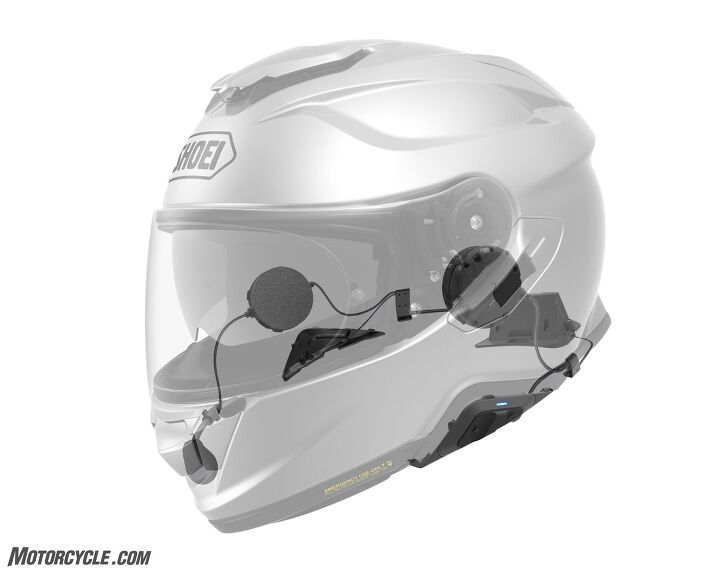
With communication systems becoming more popular, it’s only natural for the helmet and communicator manufacturers to work together to deliver optimal speaker performance and avoid messing up the helmet’s aerodynamics.
The speakers snap into place, and their location would be my only complaint about the SRL2. Placement of the speaker directly over the rider’s ear canal opening is paramount to getting the best audio out of a helmet communication system. While I’m sure that Shoei and Sena worked hard at the correct placement – on average – people’s ears are located in slightly different places on their heads. In all of my prior installations of add-on communicators, I’ve ended up placing my speakers partially forward of the helmets’ speaker pockets (this is true for Arai, Bell, and Shoei). Maybe my ears are in a funny place, but I’d like it if there were some adjustability in the speaker location.
That said, with the Audio Boost in the settings turned on and the Smart Volume Control set to medium, the sound is plenty loud for me to hear directions and music at highway speeds on a naked bike – while wearing my favorite earplugs. People I have talked to while riding have said that they can hear me clearly. I have not had the opportunity to test the intercom feature, but as a long-time fan of the Sena 20S, I expect it to work quite well. My only functional issue with the SRL2 is the same one I’ve had with the 20S, namely, the voice command feature can be hit and miss at elevated speeds. Well, that and the fact that there is no voice command to invoke Siri or Google phone controls.
As someone who doesn’t like to ride without a helmet communicator, I think the $299 price for the SRL2 is worth it for the convenience.
Wrapping it up
My time with the Shoei GT-Air II has shown it to have the quality of construction that I’ve come to expect from the manufacturer. This quality does, however, have a cost. The solid color GT-Air IIs retail for $599. Graphic versions, like the Redux TC-6 tested here, carry a $699 price tag. What you get for that money, though, is a comfortable, quiet helmet that can easily be worn all day. The GT-Air is available in sizes XS-XXL encased in three shell sizes (XS-S, M-L, and XL-XXL). The ventilation is very good, and the new first notch on the visor offers great low-speed ventilation. The included micro-ratchet chin strap fastener will make you wonder why more manufacturers don’t include them with their helmets. The fit and finish is what you’d expect from a premium helmet. Having the option to install the integrated Sena SRL2 brings even more utility to the helmet without compromising its looks or aerodynamics.
Shop for the Shoei GT-Air II here
We are committed to finding, researching, and recommending the best products. We earn commissions from purchases you make using the retail links in our product reviews and other articles. Learn more about how this works.
The post MO Tested: Shoei GT-Air II + Sena SRL2 Review appeared first on Motorcycle.com.
【Top 10 Malaysia & Singapore Most Beautiful Girls】Have you follow?